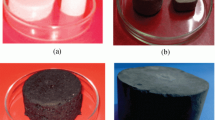Abstract
The dependence of high-temperature hydrogen activation on the structure of nanofibrous alumina (filament diameter of 5 nm) was shown. Due to self-organization, nanofibers are twisted in spirals and then in a second stage the spirals interlock and form alumina tubes, which then transform into bundles. In the process of hydrogen activation, the specific surface area changes and amorphous alumina nanowires develop into a nanocrystalline phase. TEM investigations showed that high-temperature hydrogen activation led to the self-organization of the alumina nanofibrous structure into hollow nanotubes with a diameter close to 30 nm.
Similar content being viewed by others
References
A. I. Gusev, Nanomaterials, Nanostructures, Nanotechnologies (Fizmatlit, Moscow, 2005) [in Russian].
Yu. A. Kotov, “Electric explosion of wires as a method for preparation of nanopowders,” J. Nanopart. Res. 5(5–6), 539 (2003).
Yu. A. Kotov, I. V. Beketov, A. I. Medvedev, and O. R. Timoshenkova, “Synthesizing aluminum nanoparticles in an oxide shell,” Nanotech. Russ. 4(5–6), 354 (2009).
V. V. Ivanov, A. S. Kaigorodov, V. R. Khrustov, S. N. Paranin, and A. V. Spirin, “Strong ceramics based on aluminum oxide produced by composite nanopowders magnetic-pulse pressuring,” Ross. Nanotekhnol. 1(1–2), 201–207 (2006).
B. E. Yoldas, Amer. Ceram. Soc. Bull. 3, 289 (1975).
E. V. Parkhomchuk, K. A. Sashkina, N. A. Rudina, A. G. Okunev, and V. N. Parmon, “Temperature synthesis of 3D structured macroporous oxides,” Al’ternat. Energet. Ekol., No. 10, 107–111 (2011).
J. B. Peri and R. Hunnan, J. Phys. Chem. 64(10), 1526 (1960).
J.-L. Vignes, C. Di Frappart, T. Costanzo, J.-C. Rouchaud, L. Mazerolles, and D. Michel, “Ultraporous monoliths of alumina prepared at room temperature by aluminium oxidation,” J. Mater. Sci. 43, 1234–1240 (2008).
O. K. Krasil’nikova, A. S. Pogosyan, N. V. Serebryakova, T. Yu. Grankina, and A. N. Khodan, “Synthesis of carbon nanomaterials with porous alumina as a template,” Protect. Met. 44(4), 362–366 (2008).
R. Sh. Askhadullin, A. A. Simakov, and Yu. M. Sysoev, RF Patent No. 2150429 (1998).
Naofumi Nagai, Kazuaki Ihara, Ayaka Itoi, Tetsuya Kodaira, Hiroshi Takashima, Yukiya Hakuta, Kyoko K. Bando, Naotsugu Itoh, and Fujio Mizukami, “Fabrication of boehmite and Al2O3 nonwovens from boehmite nanofibres and their potential as the sorbent,” J. Mater. Chem. 22, 21225–21231 (2012).
E. B. Markova, O. K. Krasil’nikova, and Yu. M. Serov, “Propane catalytic conversion into ethylene at activated nanofibrous aluminum oxide aerogel,” Neftepererab. Neftekhim., No. 3, 8–12 (2013).
O. K. Krasil’nikova, A. S. Pogosyan, N. V. Serebryakova, T. Yu. Grankina, and A. N. Khodan, “The way to produce carbon nanomaterials by using porous aluminum oxide as template,” Fizikokhim. Poverkhn. Zashchita Mater. 44(4), 389–394 (2008).
E. B. Markova, O. K. Krasil’nikova, Yu. M. Serov, and V. V. Kopylov, “Research of nanofibrous catalysts based on aluminum and titanium oxides in propane cracking reactions,” Butlerov. Soobshch. 34(4), 69–74 (2013).
A. S. Pogosyan, O. K. Krasil’nikova, T. Yu. Grankina, and N. V. Serebryakova, “De-hydration effect onto porous structure of monolithic aerogels based on fibrous aluminum oxyhydroxide,” Fizikokhim. Poverkhn. Zashchita Mater. 47(5), 1–7 (2011).
S. J. Gregg and K. S. W. Sing, Adsorption, Surface Area and Porosity (Acad. Press, 1982).
M. M. Dubinin, Chemistry and Physics of Carbon. Marcel Dekker (New York, 1966), Vol. 2, p. 51.
A. M. Voloshchuk and M. M. Dubinin, et al., Izv. Akad. Nauk SSSR, Ser. Khim., No. 2, 277 (1988).
M. Robitzer, A. Tourrette, R. Horga, R. Valentin, M. Boissiere, J. M. Devoisselle, and F. Di Renzo, “Nitrogen sorption as a tool for the characterisation of polysaccharide aerogels,” Quignard F. Carbohydrate Polym. 85, 44–53 (2011).
Author information
Authors and Affiliations
Corresponding author
Additional information
Original Russian Text © E.B. Markova, O.K. Krasil’nikova, Yu.M. Serov, V.V. Kurilkin, V.N. Simonov, 2014, published in Rossiiskie Nanotekhnologii, 2014, Vol. 9, Nos. 7–8.
Rights and permissions
About this article
Cite this article
Markova, E.B., Krasil’nikova, O.K., Serov, Y.M. et al. Alumina nanofibrous structural self-organization in hollow nanotubes caused by hydrogen treatment. Nanotechnol Russia 9, 441–447 (2014). https://doi.org/10.1134/S1995078014040119
Received:
Accepted:
Published:
Issue Date:
DOI: https://doi.org/10.1134/S1995078014040119



